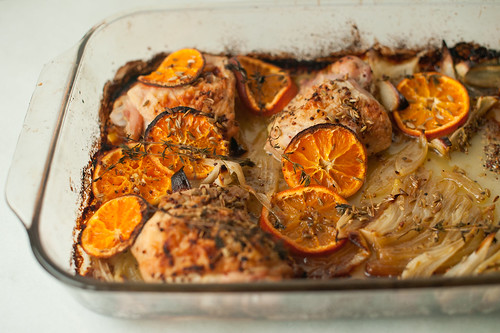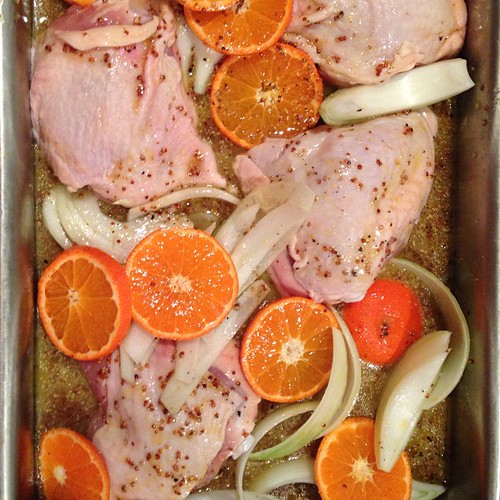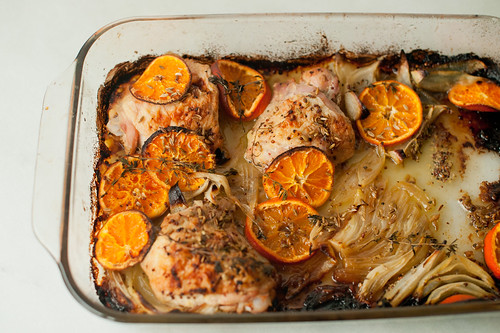roasted chicken thighs with clementines
I don’t care what anyone says, but on my bookshelf, Jerusalem has found a permanent spot as a go-to book. With all due respect to Marco Canora, I think some of his criticism (while judging this year’s Piglet contest) of the book was a little, well, I’m not sure what to call it, but I was genuinely surprised by some of his criticism. But then again, some of the criticism of the books being judged struck me as odd. Adam Roberts makes a good point when he says, some people’s garbage is other people’s treasure. Also, I’m pretty sure you can get sumac at Kalustyan’s and it’s so worth having in your spice pantry.
I get it – some of the recipes, should be more specific, and in that, the critique holds valid. Yes, it’s better to say how much salt and pepper in the ingredients if you do give a measure for it later in instructions. I’m not going to challenge that. What I am going to challenge, perhaps, is that the food, in and of itself, is gorgeous, celebratory, lush, full of joy and love, and Canora makes no mention of it. And while the recipes might have used a slightly more thorough edit, the food, in and of itself, is what truly makes this book a treasure.
I approach writing about food on this blog simply: If I see a good recipe, whether it’s something I’ve tested on my own in the kitchen, or cooked from a book, I’m going to share it with you because I feel that the only recipes worth sharing and writing about are the ones you want to shout about from tops of mountains, or in the case of living in New York – buildings. And Roasted Chicken Thighs with Clementines is one such recipe.
By the way, I should probably mention that I’m going through a serious cookbook phase in that I’m cooking a lot more from them than I have been in the last twelve months. So you should probably expect more recipes here that are adapted from or inspired by the cookbooks I’m reading. Some of them will be current and “hot” and others might be books you’ve never heard about. There’s a time and place for everything and for the time being I’m feeling like I want to learn from others. I’ve plenty of ideas of my own, but I’m not in the mood to write about them at the moment. And the best part of writing a blog is having the absolute final word in what goes up on the proverbial page, right? Right.
I’ve come into some stellar cookbooks as of late. Some I found used for pennies (and when I say pennies, I mean – pennies); others were sent to me by thoughtful relatives; others mailed by publishers (though I don’t seem to get that many of those). And I intend to get immersed in them – and share my favorites with you along the way.
The original name of this recipe is Roasted Chicken With Clementines and Arak. When I first read the title, I had to go and look up what arak was. Arak is a very strong clear spirit that’s flavored with anise. The word means “sweat” in Arabic, and the spirit is usually mixed with water: one part arak to two parts water. Since arak can be a little bit tricky to find here, the authors, helpfully, suggest you swap in pernod or ouzo. But what if you happen to be an anise hater? What if the mere hint of anise will make you push the entire dish away from you? That person, as you might suspect, happens to be me.
But the recipe (in every other way) looked so absolutely amazing, that I had to give it a go. Normally, with Ottolenghi’s recipes, I change very little because I love his palate and flavors. But no matter how much I love his food, anise is something I really dislike. And so instead of arak, I just added more fresh orange juice and hoped for a miracle, which is exactly what I got, when the chicken, browned and crisp, emerged from the oven. Some of the clementines had caramelized and their edges turned blackish, but their smell, mellow and sweet, faintly burnt, mixing with thyme and pepper, turned ambrosial. And I don’t use that word, ambrosial, lightly. The smell is intoxicating.
Ottolenghi then has you remove the chicken from its cooking vessel and makes you pour the sauce into a separate saucepan (“On a weeknight? Seriously?” I thought) and cook the sauce down to the consistency of syrup. This all seems like kind of over the top (because who wants to get an extra pot dirty? Not I!) and a bit crazy given that you’re just trying to get dinner on the table, but you need to trust this man and you need to trust his instruction. The sauce is truly that much better after you reduce it. Any residual sharpness is gone and in its place remains a pleasant, undisruptive acidity. And aisde from that extra pot to wash, the additional step is another few minutes of your time, which if you trust me by now – is so, totally, worth it.
And with this, I, still in my jammies and bathrobe, instead of climbing to the top of my building and shouting about this dish, will now take a shower and put on something civilized. I’m sure you’ll understand.
More Ottolenghi Here: I cooked a few things from the book already, but blogged only one other: roasted butternut squash and red onion with tahini and za’atar. Needless to say, it’s become one of our favorites.
Roasted Chicken Thighs With Clementines
Adapted from Jerusalem, by Ottolenghi and Tamimi
A few quick notes, which I highly recommend you read: First, there’s no need to marinade overnight, but if you’re the sort of intrepid cook who really plans ahead (kudos to you) the dish will definitely benefit from it. Secondly, I gave both the arak and the non-arak versions of the dish. In my opinion, with deep respect to Chef Ottolenghi, I find arak (and its cousins) to be displeasing to the palate. Thirdly, there are some of you out there, and I was once one of you, who greatly dislike fennel. In making this, I was once out of fennel and made this with the equivalent amount of onions. I like both versions equally, but for the fennel-haters, the onions will work much better, while for the onion-haters (they exist), the fennel options will sound far more appealing. [metric measurements coming shortly!]
6 1/2 tablespoons arak, ouzo, or Pernod (I used fresh orange juice)
1/4 cup olive oil
3 tablespoons fresh orange juice (if using just orange juice, you need about 9 tablespoons or 1/2 cup plus 1 1/2 tablespoons orange juice), plus additional should you need more liquid
3 tablespoons fresh lemon juice
2 tablespoons grain mustard
3 tablespoons light brown sugar
2 teaspoons kosher salt, plus additional to taste
1 teaspoon freshly ground black pepper, plus additional to taste
2 medium fennel bulbs (500 grams; 1 pound); also, okay to swap in onion for some of all of the fennel, if you can’t stand fennel
3 pounds (1.4 kg) skin-on, bone-in chicken thighs, or 1 (3-pound) chicken cut-up into pieces
4 clementines, unpeeled, sliced 1/4-inch thick circles
1 tablespoon fresh thyme leaves
3 teaspoons fennel seeds, slightly crushed
Chopped flat-leaf parsley to garnish
1. In a large mixing bowl combine the arak, olive oil, orange juice, lemon juice, mustard, sugar, salt, and pepper with 1/3 cup water.
2. Trim the fennel and halve each bulb lengthwise. Quarter each half so you have wedges and add fennel to the liquid along with the chicken pieces, clementine, thyme, and fennel seeds. Give everything a nice stir, so that the chicken is well-coated in the marinade, cover with plastic wrap, and refrigerate for a few hours or overnight. If you didn’t plan ahead and don’t have a few hours (or overnight) making this on the go works out beautifully.
3. Position the baking rack in the middle and heat the oven to 475 degrees F (220 degrees C). Divide the chicken and all the marinade and its components across 2 (9x13x2-inch) roasting pans, so that there is enough room to accommodate everything comfortably in a single layer. Make sure the chicken skin is facing up. Roast for about 35 minutes or until the chicken is nicely browned and cooked through. The edges of some of the clementines will start to look burnt. Check on the chicken about 25 minutes into the roasting process and if you think that the liquid is beginning to dry up add 1/4 cup more water (or use your judgment). When the chicken is done, remove from the oven, and transfer the chicken, fennel, and clementines to a platter, cover, and keep warm.
4. Pour the cooking liquid into a small saucepan, place over medium-high heat, and bring to a boil. Simmer the sauce until it is reduced by one-third and is the consistency of syrup, about 7 minutes. You should be left with about 1/3 cup. If, by the time your pour the sauce, there’s already less than 1/3 cup, add a splash or orange juice to the saucepan, along with the caramelized crispy pan drippings, and bring to a simmer, reducing as instructed above. You want a thick, syrupy consistency. Pour the sauce over the chicken, fennel, and clementines, garnish with parsley, and serve.



kickpleat
Yum, I love reading through all the Piglet reviews. I have Plenty & have never made anything from it since I find it a bit fussy. I’m curious about Jerusalem though and this looks wonderful – especially with more orange juice added.
olga
kickpleat – i hear you on fussy, but the Plenty really is terrific. Most of his food, in fact, is a bit fussy, but I don’t mind since the results are mind-blowing.
Helene @ French Foodie Baby
Just discovered your blog, enjoyed your writing very much. And this recipe sounds awesome, I will most definitely give it a try in the coming weeks (sans anise but with fennel!) and take full advantage of clementine season. Beautiful photos as well.
olga
Helene – thank you so much! I hope you like this recipe – we went sort of crazy for it. And yes, anise free, in my opinion, is the way to go!
Brian @ A Thought For Food
I’m obsessed with this book. I think I could spend the rest of my life just eating those dishes and be a very happy man. And this chicken… well, it makes me wish I ate meat. If you invite me over for dinner, I may just consider having a bite. ;-)
merry jennifer
Like you, I don’t want anise anywhere near my food. Your non-arak version sounds like just my thing.
Karen
Hi Olga, Love your blog! This was the first (of many) recipes I’ve made from Jerusalem. The thing that got me, though, was the clementines…I don’t like sweet orange-y chicken. But I do love anise and pernod, so I swapped the clementine for lemon, added onions, and it was a huge hit!
olga
Brian – ha, if you don’t eat meat, I won’t make you.
MJ – great mind, right?
Karen – I totally get it, but happen to love it. Glad your version worked out beautifully!
Elliott
Olga,
This recipe looks glorious. I, too, have been on a major cookbook jag – but primarily wonky, old Southern ones.
I have chicken thighs. I have blood oranges (!).
Looks like I have my kitchen project for the evening…
Thanks!
XO,
Elliott
Gloria
Do you eat the clementines in this dish or are they served on the platter to show what has flavored the dish? Surely all that would be left after cooking is the membrane and peel. Is the peel eatible when it is cooked?
olga
Gloria – when the clementines emerge from the oven they are caramelized but not disintegrated. We ate them with our chicken and it was delightful. In fact, we fought for the last clementine bit. With that in mind, it’s best to get organic ones, though I think those are pretty hard to come by.
Ellen @ CheapCooking
I made this a few weeks ago, without the arak or fennel because I didn’t have any. It was delicious! I’ve been meaning to make it again sometime and have another bag of clementines in the kitchen so I think it will be this weekend.
Carol Sacks
Don’t know how I missed this post, but I couldn’t agree more with your thoughts on the Piglet review. I love this book not just for the recipes, but for the inspiration to go off and improvise. Like you, I’m not an anise-lover, so I’m going to make your adaption of this recipe. Lovely post, Olga!
orly @yumivore
Love the flavors of this chicken recipe. The arak reminds me of my father and even my own childhood, it adds wonderful flavor to the dish and I hadn’t cooked with it until this recipe. I love fennel (also for it’s anise flavor) great suggestion though for those who wish to adapt to their palate. Delicious!
Katie@Cozydelicious
This dish looks so flavorful! The citrus, fennel, mustard…. yum!
Beth (OMG! Yummy)
I 100% agree with you about the Piglet review. While he is absolutely right that there are details missing, the creativity and storytelling for me far outweigh any editorial or writing errors. I made this chicken last night with a few little spins of my own but the genius of the ingredient combination and cooking technique is all theirs and puts this book high on my list of great cookbooks – and apparently Gourmand agrees!
Roasted Chicken with Clementines, Onion, and Vermouth - OMG! Yummy
[…] be that good? I’m not even an anise flavor lover – would I even like it? Olga from the blog Sassy Radish wrote about it last week with more gushing about its simplicity on a weeknight and oh yes, the […]
Weekly Menu Plan 3/4-10, 2013 | Monica's Nest
[…] Roasted Chicken Thighs with Clementines, Butternut Squash & Red Onion w/ Tahini & Za’atar. (From […]
Do you menu plan? | 52 crafts in 52 weeks
[…] Monday: Korean Tilapia with baby Bok Choy (via pinterest). This was amazing! Will definitely be making it again. Tuesday: Black bean cakes (p 224 weelicious cook book and online here) with broccoli and greek yoghurt. Emily loved the bean cakes. Mummy was pretty enamored with them too. Wednesday: Green macaroni and cheese (another weelicious online recipe) a delicious way of adding more greens to our diet. Thursday: leftover pasta Friday: Leek & chive flan, smoked salmon, asparagus, sweet potato (recipe via French Foodie Baby) well Ben and Emily weren’t too impressed with the flan but I loved it. Maybe I’ll try it again with different flavours. Saturday: dinner out Sunday: roasted chicken thighs with clementines from Jerusalem cook book (also online here). […]
Julia
I completely concur with your take on the Piglet review and was surprised that chef Canora gave so little credit to the inspirational creativity of Jersuleum.
about Inspirato. | food
[…] Chicken Thighs with Blood Orange *inspired by Sassy Radish‘s Roasted Chicken Thighs With Clementines which was inspired by Jerusalem, by […]
Modest Chef
You couldn’t really have “tested” this recipe in your own kitchen, because you reproduce Y.O.’s temperatures–which are wrong. 475 degrees F is nowhere near 220 degrees C. Elsewhere in the book, 475 is said to be 240, and once he actually gets it right: 425 = 220. Delicious dish, though, once you figure out the error.
olga
Modest Chef – I use Fahrenheit and it worked great at 475. If my math is wrong, that’s one thing, but to suggest that I didn’t test the recipe – especially in the passive aggressive manner you did putting quotes around the word tested – is accusatory and not very nice. I’m but one person here on this blog. Typos and math errors happen. If they do, please correct me and I’ll happily amend my error. Just don’t accuse me of lying.
Frank
Well, I’ve wondered about the temperature myself, because I’ve cooked this twice and both times it’s absolutely charred the veggies, leaving no sauce at all. Chicken tastes great, still haven’t managed to make any sauce!
olga
Frank is it possible that your oven runs hotter than usual? Try adjusting the heat…